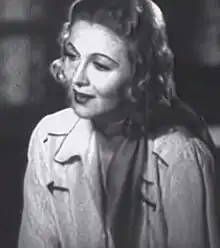Dorothy Page | |
|---|---|
 Page in The Singing Cowgirl in 1938 | |
| Born | Dorothy Lillian Stofflett March 4, 1904 |
| Died | March 26, 1961 (aged 57) LaBelle, Florida, U.S. |
| Occupation(s) | Film actress, singer |
| Spouses |
|
Dorothy Page (March 4, 1904 – March 26, 1961), also known as The Singing Cowgirl, was a B movie film actress during the 1930s.
Early life and education
Dorothy Page was born Dorothy Lillian Stofflett[1] on March 4, 1904, in Northampton, Pennsylvania.
In the 1920s, Page attended Cedar Crest College, where she majored in music.[2]
Career
Modeling
Page was chosen by the Curtis Publishing Company in the 1920s as a model for a Saturday Evening Post cover. Her portrait, painted by artist Neysa McMein,[2] dubbed her "One of America's Ten Most Beautiful Women".
Singing career
Page tried out for the "Youth of America" in a singing contest hosted by Paul Whiteman, and won. With that, her radio and singing career began, and her stage name was created. By 1935, she was a regular on the Paducah Plantation, written and hosted by Irvin S. Cobb.
Acting career
That same year, Universal Pictures signed her to a contract. Her first film was Manhattan Blue, starring opposite Ricardo Cortez, which saw moderate success and placed a spotlight on her talent as a singer and an actress. She then starred in King Solomon of Broadway opposite Edmund Lowe and Pinky Tomlin. That film was only moderately successful, and it wasn't until 1938 that she starred in another film, this time alongside Mary Boland and Ernest Truex in Mama Runs Wild. That movie also was not successful, and Page was not given any singing parts in the film.
In late 1938, Grand National Pictures announced its intention to do a series of cowboy based films utilizing a "Singing Cowgirl".[3] The first of these was Water Rustlers in 1939, starring Page[4] and Dave O'Brien. Unfortunately the movie-going public did not accept a woman in the lead role of a western.
Ride 'Em Cowgirl was released next, that same year, and fared even worse than the first. Later that same year, The Singing Cowgirl was released,[5] in which Page again starred with O'Brien. It would be the last film by Grand National Pictures, and shortly thereafter they went out of business.
In 1947, Page appeared on Broadway in the drama Dear Judas.[6]
Retirement
Following the failure of the three "singing cowgirl" films, and the end of Grand National Pictures, Page retired from acting. Page began working in realty, buying old Hollywood houses, remodeling them and selling them at a profit. This second career proved very successful financially.
She and husband Henry Clark McCormick lived at his ranch in Fresno. Page purchased a 1,700-acre (6.9 km2) cotton ranch near Pecos, Texas. During the 1950s, she was diagnosed with cancer and began a long and painful battle against it. She moved to LaBelle, Florida, to be closer to Fort Myers, where she was receiving cancer treatment.
Personal life
On July 3, 1925, at age 21, Page married Waldo Shipton of Detroit, a doctor she met in college at Cedar Crest College. The couple had two daughters by 1929. They divorced in 1932. Later, she married Los Angeles attorney Frederick D. Leuschner, and they resided at his ranch in Tarzana, California. He died on December 6, 1941, at age 36 from heart failure. She then married Henry Clark McCormick of Fresno, California. They divorced after she was diagnosed with cancer.
Death
Page died in LaBelle, Florida, from cancer on March 26, 1961, at age 57.
Homage
In one of Columbo's episodes ("Ashes to Ashes", Season 10 Episode 12), she may have been portrayed in the character of Dorothea Page, the deceased silent film star from whom Patrick McGoohan (in his role as Eric Prince, funeral director to the stars) stole a valuable diamond off her deceased body. Portraying her in this episode as a silent movie star may have been to show the way society in the late 1930s wanted to silence the "Singing Cowgirl".
References
- ↑ "(photo caption)". The Des Moines Register. Iowa, Des Moines. November 25, 1934. p. 69. Retrieved January 18, 2018 – via Newspapers.com.

- 1 2 Rayno, Don (2012). Paul Whiteman: Pioneer in American Music, 1930–1967. Scarecrow Press. p. 357. ISBN 9780810883222. Retrieved January 19, 2018.
- ↑ Aquila, Richard (2015). The Sagebrush Trail: Western Movies and Twentieth-Century America. University of Arizona Press. p. 121. ISBN 9780816531547. Retrieved July 25, 2018.
- ↑ Young, William H.; Young, Nancy K. (2007). The Great Depression in America: A Cultural Encyclopedia. Greenwood Publishing Group. p. 478. ISBN 9780313335228. Retrieved January 19, 2018.
- ↑ Drew, Bernard A. (2013). Motion Picture Series and Sequels: A Reference Guide. Routledge. p. 100. ISBN 9781317928942. Retrieved January 19, 2018.
- ↑ "Dorothy Page". Internet Broadway Database. The Broadway League. Archived from the original on January 19, 2018. Retrieved January 19, 2018.
External links
- Dorothy Page at IMDb
- Dorothy Page at AllMovie
- Dorothy Page at b-westerns.com